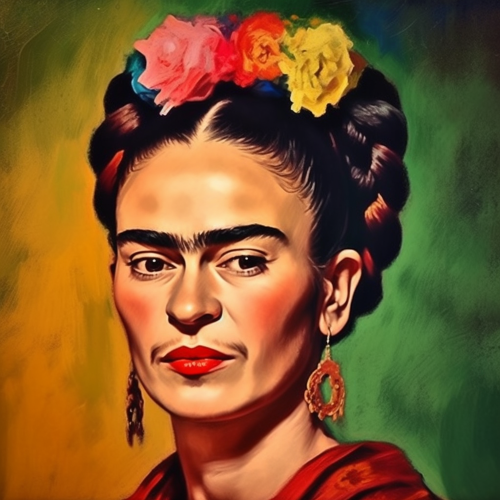¶ Frida Kahlo: A Journey of Passion, Pain, and Empowerment

¶ Introduction
In the world of art, few individuals have left an indelible mark on the canvas of history like Frida Kahlo. This extraordinary Mexican painter is celebrated for her unique style, vivid self-portraits, and unbreakable spirit. Frida's life was a tapestry woven with passion, pain, and resilience, making her an eternal source of inspiration, especially for women worldwide.
¶ Early Childhood and Personal Challenges
Frida Kahlo was born on July 6, 1907, in Coyoacán, Mexico City. Her life was deeply influenced by her mixed heritage, embracing both her German and Mexican ancestry. As a child, Frida suffered from polio, which left her right leg visibly thinner and weaker than the other. This early experience of physical adversity shaped her determination to overcome challenges throughout her life.
¶ The Tragic Accident and the Birth of an Artist
At the age of 18, Frida's life took a dramatic turn when she suffered a devastating bus accident. The accident resulted in severe injuries, including a fractured spine, a broken pelvis, and multiple fractures in her right leg. During her arduous recovery, Frida discovered her passion for painting. She used art as a means of self-expression, pouring her emotions onto the canvas and creating a visual autobiography of her pain, suffering, and resilience.
¶ Artistic Style and Achievements of Frida Kahlo
Frida Kahlo's artistic style was characterized by vibrant colors, intricate details, and symbolic imagery. Her self-portraits were a prominent feature of her work, allowing her to explore her identity, personal struggles, and the complexities of femininity. Frida's art embodied her Mexican heritage, often incorporating traditional motifs, indigenous elements, and bold symbolism.
¶ A Trailblazer for Women Artists
As a woman artist in a male-dominated field, Frida Kahlo challenged social expectations and questioned traditional norms. She paved the way for women artists to reclaim their narratives, express their truths, and transcend barriers. Frida's art became a vehicle for social commentary, addressing issues of gender, identity, and the human condition. Her work continues to inspire countless women artists today, empowering them to embrace their unique perspectives and make their voices heard.
¶ Recognition and Legacy
Frida Kahlo's artistic talent and indomitable spirit earned her recognition both in life and after her death. Her first solo exhibition took place in New York in 1938, gaining international acclaim for her art. Today, her paintings are displayed in prestigious galleries around the world, captivating audiences with their raw emotion and profound narratives. Frida's legacy transcends the art world, symbolizing resilience, authenticity, and female empowerment.
¶ Inspiring Women Across Generations
Frida Kahlo's unapologetic embrace of her physical and emotional scars challenged conventional beauty standards and inspired women to love and accept themselves as they are. She showed the world that vulnerability and strength can coexist and that true beauty lies in authenticity.
¶ Empowering Women's Voices
Frida's art and life experiences amplified the voices of women worldwide. Through her paintings, she shed light on the universal struggles faced by women, addressing topics such as motherhood, infertility, identity, and social expectations. Her unwavering commitment to capturing her truth and reclaiming her narrative inspired women to do the same, fostering a sense of empowerment and solidarity.
¶ Death
Frida passed away on July 13, 1954, at the age of 47. The exact cause of her death has been debated among historians and biographers. According to the death certificate, the official cause of her death was a pulmonary embolism.
¶ Conclusion
The life and artistic journey of Frida Kahlo continue to captivate hearts and minds, transcending the barriers of time and geography. Her unyielding resilience, deep self-expression, and relentless pursuit of truth are a beacon of hope and inspiration for women worldwide. Frida's legacy endures, reminding us to embrace our own complexities, celebrate our unique stories, and find strength in the face of adversity.
¶ Frequently Asked Questions (FAQs)
¶ Q: Where can I see Frida Kahlo's paintings?
A: Frida Kahlo's paintings are exhibited in various museums and galleries around the world, including the Frida Kahlo Museum in Mexico City, the Museum of Modern Art (MoMA) in New York, and Tate Modern in London.
¶ Q: What is Frida Kahlo's most famous painting?
A: One of Frida Kahlo's most recognized paintings is "The Two Fridas," which depicts two versions of herself holding hands. This painting explores themes of duality and self-identity.
¶ Q: Did Frida Kahlo only paint self-portraits?
A: While Frida Kahlo is best known for her self-portraits, she also created other types of artwork, including still-life, portraits of friends and family, and depictions of Mexican culture and folklore.
¶ Q: Was Frida Kahlo actively involved in politics?
A: Yes, Frida Kahlo was an active political figure and had strong affiliations with communist and socialist movements. Her art often carried political messages, reflecting her commitment to social justice.
¶ Q: How did Frida Kahlo influence the art world?
A: Frida Kahlo's art and life story challenged traditional artistic norms and paved the way for future generations of artists. She empowered women to use art as a means of self-expression and opened doors for diverse narratives in the art world.
¶ Q: What impact did Frida Kahlo have on feminism?
A: Frida Kahlo's unapologetic representation of physical and emotional challenges contributed to the feminist movement. She became an icon of self-acceptance, body positivity, and reclaiming women's narratives.
¶ Q: Did Frida Kahlo teach art at any point?
A: Yes, Frida Kahlo briefly taught art at La Esmeralda, the National School of Painting, Sculpture, and Engraving in Mexico City.
¶ Q: How did Frida Kahlo's art change after her accident?
A: Frida Kahlo's art underwent a significant transformation after her accident. Her paintings became deeply introspective, exploring themes of pain, identity, and the human experience with renewed intensity.
Sources:
https://www.frida-kahlo-foundation.org/biography.html
https://en.wikipedia.org/wiki/Frida_Kahlo
https://www.britannica.com/biography/Frida-Kahlo
https://blog.oup.com/2017/01/frida-kahlos-life-of-chronic-pain/ (Oxford Universtiy Press)